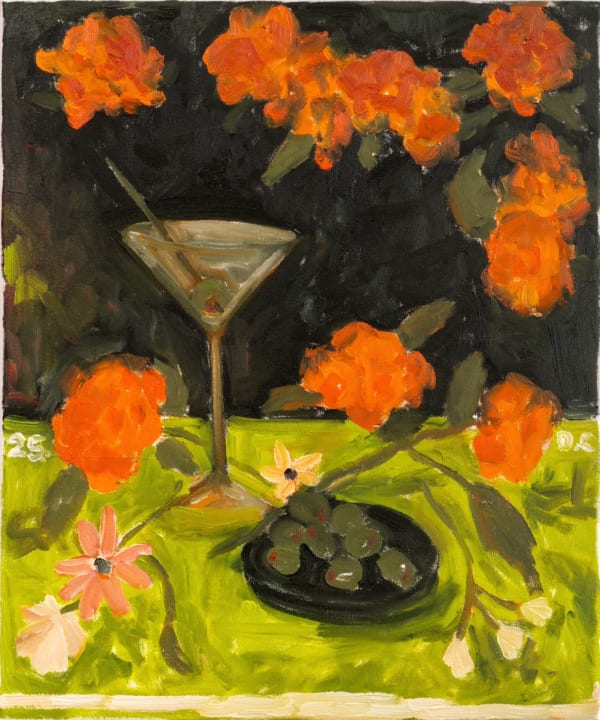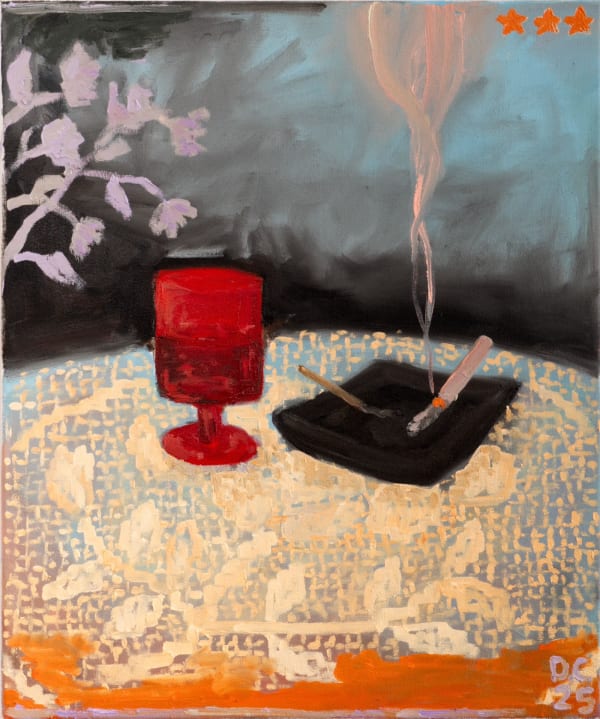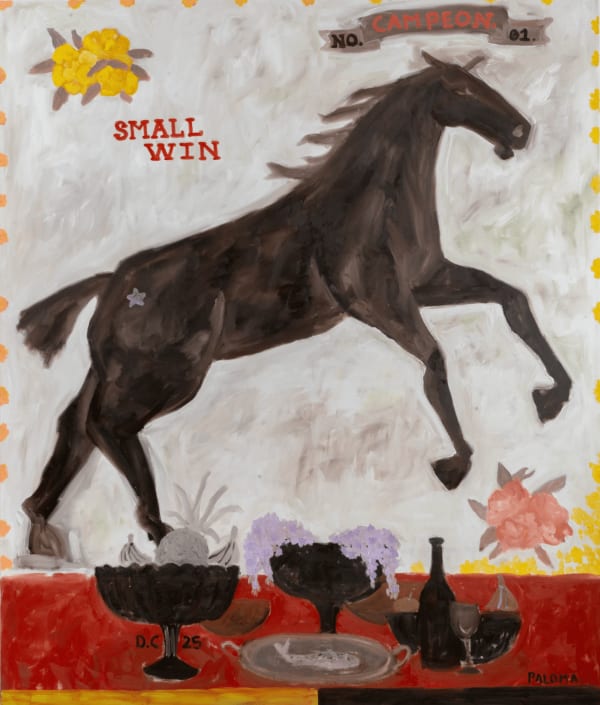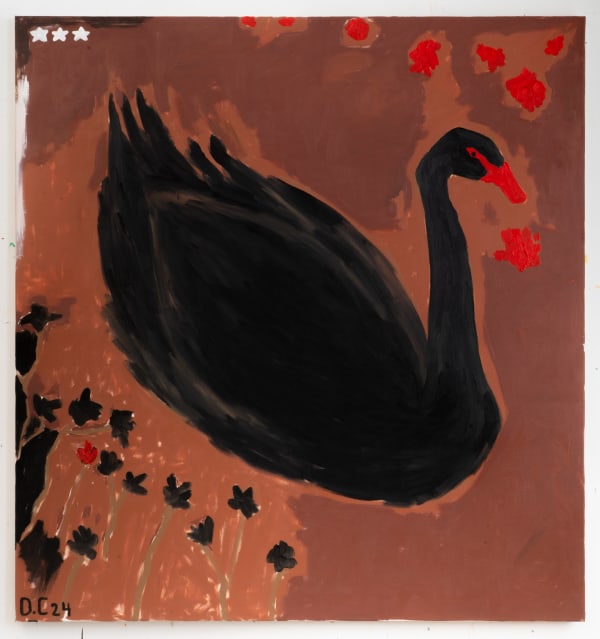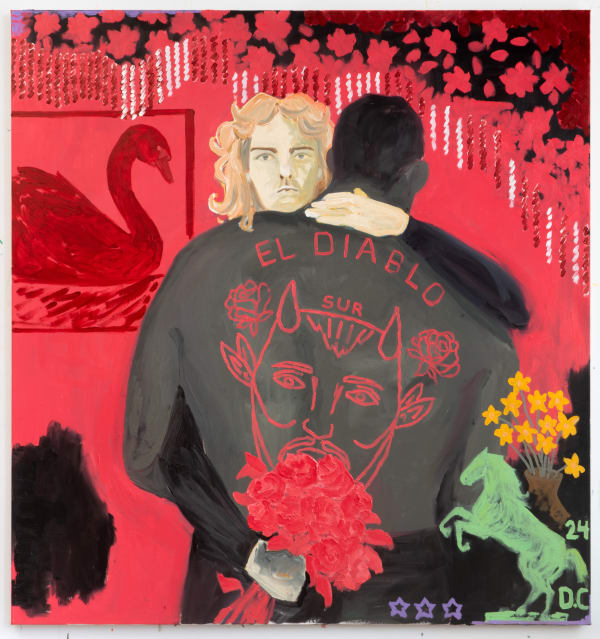-
OverviewCantor’s paintings both record as well as project onto his day to day life, they celebrate,
romanticise, reminisce and grieve. resulting in not just paintings but a practice that is
multilayered and personal. Recurring motifs, familiar imagery, personal objects, daily life,
close relationships, personal desires, snippets of life and traumas - they are shaped by the
act of painting itself with the painting process as the driving force behind the decisions made.
Beneath Cantor’s expressive paintings lies a much more personal, emotional and private
aspect of his work, an assortment of personal jokes and inside anecdotes that are woven
into the imagery of the paintings, like layers to a person, its meaning ready to resonate with some but not all. Cantor's titles and writing serve as a sort of bridge offered to the viewer, a window to the meaning behind the marks as well to his emotional and mental state.
As a Latino immigrant to the UK, a common motive in Cantor’s paintings is the exploration of diaspora identity and the transfiguration of culture through the experience of the immigrant, resulting in images often punctuated by feelings of segregation, rejection and discrimination that simultaneously manage to remain romantic and idealized, wishful and hopeful. They preserve the dreamings of the immigrant in what may be a collective cultural version of the lie sold as the American Dream, but in this case, his own.
Through this aspect of his work, Cantor tries to come to terms with the ways his culture and
identity have mutated through his experience of immigration. His work delves into what it
means to not belong here or there, feelings of a fragmented life and the stark contrast of
realities between the place that was left behind and the, often unwelcoming, new place.
Circumstances and experiences all too familiar to the immigrant that simultaneously
strengthen and dilute what it means to him to be from somewhere else, somewhere past, or nowhere at all.
-
Works
-
Biography
EDUCATION
2013–2015
BA (Hons) Camberwell College of Arts, University of the Arts London, UK
2012
Foundation Diploma in Art and Design, CCW Progression Center, University of the Arts London, UK
SOLO EXHIBITIONS
2021
- Guts Gallery, London, UK, “Always Late to The Party”
- Liliya Art Gallery, London, UK, “Cry, Cowboy, Cry”
- Guts Gallery, London, UK, “Horses and Nudies”
SELECTED GROUP EXHIBITIONS
2024
- Love waxes cold, London, UK, “RUNNY NOSE”
- Enari Gallery, Amsterdam, The Netherlands, “Meet the Cantors”
2023
- Union Gallery, London, UK, “UNI[2]ON”
- Wolfgang Gallery, Atlanta, USA, “The Front Room”
2022
- Enari Gallery, Amsterdam, The Netherlands, “In Motion”
- Eve Liebe Gallery, London, UK, “En Vivo Y A Todo Color”
2021
- NBB Gallery, Berlin, Germany, duo show “Achy Breaky Heart”
- Guts Gallery, London, UK, “Reality Check”
- Guts Gallery, London, UK, “A New Art World”
- Guts Gallery at Sadie Coles HQ, London, UK, “Introducing”
- Union Gallery, London, UK, “Holding Hands”
- Guts Gallery, London, UK, “When The Shit Hits the Fan Again”
2020
- Grand Teatret, Copenhagen, Denmark, “Group Exhibition”
- Bowes Parris Gallery, London, UK, “Curated for Covid”
- Everyday Gallery, Antwerp, Belgium, “Limbo”
- Guts Gallery, London, UK, virtual show “Begin Again”
2019
- Delphian Gallery / Guts Gallery, London, UK, “Delphian X Guts”
- Trestle Gallery, New York, USA, “Lobster Dinner”
- Ultrastudio, Pescara, Italy, duo show “Exceso De Rudeza”
2018
- Union Gallery, London, UK, “They Said I Was Special”
- The Lightbox Museum, Woking, UK, “Young Contemporary Talent From The Ingram Collection”
- MO Gallery, Berlin, Germany, “Opening Exhibition”
2016
- The Cello Factory, London, UK, “Young Contemporary Talent Prize”
2015
- The Lightbox Museum, Woking, UK, “Where Is God Now?”
- Hoxton Arches, London, UK, “Rock, Paper, Scissors”
- Camberwell College of Arts, London, UK, “Undergraduate Summer Show”
- GX Gallery, London, UK, “The 24 Hour Project”
- Camberwell College of Arts, London, UK, “Interim Show”
2014
- Copeland Gallery, London, UK, “Parallel Cities”
PARTICIPATION IN ART FAIRS
2025
- Art Rotterdam’25 (with Enari Gallery), Rotterdam, The Netherlands
- UVNT (with Enari Gallery), Madrid, Spain
2024
- Art Athina (with Enari Gallery), Athens, Greece
- Art Island (with Enari Gallery), Amsterdam, The Netherlands
- Amsterdam Art Week (“Meet the Cantors” with Enari Gallery), Amsterdam, The Netherlands
2021
- “Messe in St. Agnes” (with König Galerie), Berlin, Germany
MUSEUM COLLECTIONS
The Ingram Collection of Modern and Contemporary British Art
PRESS
2018
- Feather, Stephen. “Douglas Cantor.” Floorr, 10 July 2018, www.floorrmagazine.com/issue-16/douglas-cantor.
2018
- Vanessa and Martin. “A catalyzer of thoughts and experiences.” Dateagle Art, 24 July 2018, https://dateagle.art/sophie-and-douglas-cantor-interview/.
-
Exhibitions
-

Meet the Cantors
Douglas Cantor, Sophie Vallance Cantor 30 May - 13 July 2024Enari Gallery is proud to announce Meet the Cantors, a duo exhibition showcasing the works of partners Douglas Cantor and Sophie Vallance Cantor. Their third collaboration, Meet the Cantors, showcases...Read more -

In Motion
Opening Show | Co-curated by Tesoro 19 November 2022 - 7 January 2023To set In Motion implies causing something to start moving. It's commonly used metaphorically to indicate the start of, the initiation of, or to trigger a new beginning. The term...Read more
-
-
Art fairs
-

Art Rotterdam 2025
Rotterdam AHOY 27 - 30 March 2025We are pleased to announce that Enari Gallery will be participating in the 25th edition of Art Rotterdam, celebrating the new location at Rotterdam AHOY....Read more -

UVNT Art Fair 2025
6 - 9 March 2025Enari Gallery is thrilled to announce its debut in UVNT with a selection of works by represented artists Douglas Cantor, Ioanna Limniou, Tom Solty, and...Read more -

Art Athina 2024
19 - 23 September 2024Enari Gallery is delighted to participate in Art Athina 2024. One of the oldest art fairs in Europe, Art Athina has been active since its...Read more -

Amsterdam Art Week 2024
30 May - 2 June 2024Enari is pleased to announce, ‘ Meet the Cantors ’ for this year's 13th edition of Amsterdam Art Week! In their third collaboration, Sophie Vallance...Read more -

Art Island 2024
17 - 19 May 2024Enari will make its debut at the third edition of the Art Island art fair with Douglas Cantor's short film EL DIABLO AND THE PAINTER...Read more
-
-
Contact Form
Send me more information on Douglas Cantor
Colombian, b. 1989
Stay in touch with Enari
Joining the Enari newsletter is the best way to stay informed about our latest shows, fairs, and artists' news
* denotes required fields
We will process the personal data you have supplied to communicate with you in accordance with our Privacy Policy. You can unsubscribe or change your preferences at any time by clicking the link in our emails.


